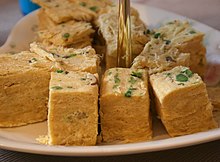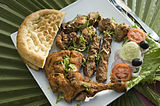Soan papdi
This article needs additional citations for verification. (May 2023) |

Soan papdi (also known as san papri, shompapri, sohan papdi, shonpapdi or patisa)[1] is a popular dessert in the Indian subcontinent. Soan Papdi has no confirmed origin[2] however is assumed to have originated in western state Maharashtra.[3] However, According to a culinary anthropologists, soan papdi is of Persian origin and the name comes from the term sohan pashmaki.[4] It bears some resemblance to the Dragon's beard candy in China, Kkul-tarae in Korea,[5] Persian pashmaki, which gave rise to the Turkish pişmaniye.[6] It is usually cube-shaped or served as flakes, and has a crisp and flaky texture. Traditionally sold loose in rolled paper cones, modern industrial production has led it to being sold in the form of tightly formed cubes.[1]
Ingredients
Its main ingredients are sugar, gram flour, flour, ghee, almond, milk, and cardamom.[7]
See also
- Sohan (confectionery)
- Sohan halwa
- Pişmaniye, a similar Turkish dessert
- Pashmak, a similar Iranian dessert
References
- ^ a b "Soan Papdi". Food-india.com. Retrieved September 17, 2012.
- ^ https://www.tastingtable.com/1067536/soan-papdi-the-simple-indian-sweet-thats-everywhere-during-diwali/
- ^ https://www.indiatimes.com/explainers/trending/explained-how-was-soan-papdi-invented-582782.html
- ^ "Diwali is incomplete without soan papdi; what makes this humble dish so popular in India?". Indian Express. Retrieved 2023-09-09.
Kurush F Dalal, archaeologist and culinary anthropologist, calls it an "incredibly versatile" dish. "Soan papdi is a Persian dish. It comes from [the word] 'sohan pashmaki'.
- ^ "Cotton Candy". stonesoup.com. Retrieved 2023-04-12.
- ^ "20 Indian Desserts You Need to Try - Nomad Paradise". Nomad Paradise. 2022-01-30. Retrieved 2022-04-11.
Believed to have been derived from the Turkish Pismaniye, soan papdi is often referred to as Indian candy floss as it has a strand-like texture that makes it so soft and flaky.
- ^ "Diwali". Indiaoz.com.au. Retrieved September 17, 2012.
External links
- Annotated video recipe illustrates traditional hand-made technique for creating Soan Papdi's crisp multi-layers (filmed at Shreya's Sweets Hampankatta, Mangalore); ·Permaculturetravel· YouTube Channel
- Demonstration of modern mechanized equipment in the making of pişmaniye, a related Turkish confection

